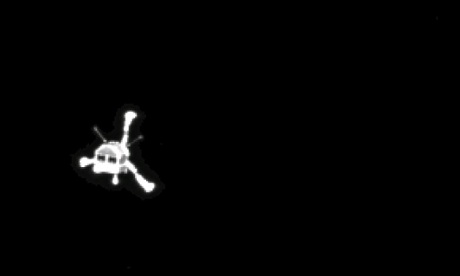可研究慧星上的水(如果有)是否類似地球的,如果是,地球的水可能就是慧星撞擊所帶來的。
【十年太空夢首次登陸彗星 人類文明邁出巨大一步】文: 場邊故事
「登陸!我的新地址:彗星67P」幻想成真!十年的太空旅程,機械人「菲萊號」(Philae)今晨登陸彗星,這個與小王子的B612星球神似的彗星67P,距離地球5億公里,完成了科學家的夢想:人類首次成功登陸劃過長空的彗星,找尋人類生命之源的秘密。
45年前,彗星67P首次被地球人發現。「我們在1969年第一次看到它的微光,今天,我們在上登陸。」歐洲太空總署(ESA)的科學家今日凌晨興奮宣布,人類有史以來首次成功登陸彗星,過往太空船總是撞毁灰飛煙滅。
「太遠,太遠了,拖著這個身體太重了」
今次漫長的太空旅程得來不易,飛船十年前啟航,曾繞地球三次,借助地球的重力揈到老遠的木星軌道附近,追上彗星 67P。靠太陽能推動的飛船曾因為距離太陽太遠,無力前行,控制中心唯有把它「催眠」,讓它在太空沉睡了兩年半,期間和地球失去聯絡。後來在預定時間甦醒及向 67P 最後進發,歐州太空署才鬆一口氣。
昨晚11時半,登陸器「菲萊號」成功脫離太空船着陸,單是着陸的訊息已要半小時才抵達德國的控制中心。登時中心內掌聲雷動,工作人員互相擁抱,為一個不可能的夢實現了喜極而泣。
肩負重任的「菲萊號」重100公斤,卻只有一個鞋盒大小,包括可鑽9吋深的鑽等十件精密儀器,採集原始物質進行分析。天文物理學家們希望這項任務,能成為瞭解太陽系及地球生命起源的一大里程碑。
彗星探索能否成功仍存隱憂,科學家發現「菲萊號」登陸了兩次,第一次着陸時曾彈跳了一下,再停在表面。而且上面用以抓緊彗星的魚叉未能成功發射,科學家要今日稍後時間再確定。
縱然命途未卜,今晨科學家收到第一張67P表面的相片時,已邁出下「人類文明的一大步」。連Google也來凑慶,「菲萊號」今天當上把谷歌塗鴉(Doodles)主角。
「菲萊號」,你可有帶着小王子回家?
BBC News - 53 mins ago
CNN.com - 2 hours ago
Philae spacecraft makes historic landing on comet
Rosetta mission’s safe landing gives scientists their first chance to ride a comet and study close up what happens as it gets closer to the sun
• Rosetta mission landing: follow the live reaction
• See the historic landing in pictures
• Usama Hasan: mission will help illuminate origins of life
• Rosetta mission landing: follow the live reaction
• See the historic landing in pictures
• Usama Hasan: mission will help illuminate origins of life
The signal broke a seven-hour wait of agonising intensity and sparked scenes of jubilation at the European Space Agency’s mission control in Darmstadt. The team in charge of the Rosetta mission achieved what at times seemed an impossible task by landing a robotic spacecraft on a comet for the first time in history.
The moment the tension broke came shortly after 1600 GMT when the Philae called home. “We are there. We are sitting on the surface. Philae is talking to us,” said a jubilant Stephan Ulamec, Philae lander manager at the DLR German space centre. “We are on the comet.”
Andrea Accomazzo, the Rosetta flight operations director, added: “We cannot be happier than we are now.”
But celebrations were tempered by the later discovery that the probe’s two harpoons had not fired to fasten the craft down in the ultra-low gravity. Scientists now think the probe may have bounced after first coming into contact with the surface. Ulamec said: “Maybe today we didn’t just land once, we landed twice.”
The safe, if precarious, touchdown of the lander gives scientists a unique chance to ride onboard a comet and study from the surface what happens as its activity ramps up as it gets closer to the sun. The first images beamed back from the lander’s descent revealed a dramatic landscape of pits and precipices, craters and boulders. However, there have been gaps in its radio link with the orbiting Rosetta mothership.

The £1bn ($1.58bn) Rosetta mission aims to unlock the mysteries of comets, made from ancient material that predates the birth of the solar system. In the data Rosetta and Philae collect, researchers hope to learn more of how the solar system formed and how comets carried water and complex organics to the planets, preparing the stage for life on Earth.
Space agencies have sent probes to comets before, but not like this. In 1986, Nasa’s Ice mission flew through the tail of Halley’s comet. In 2005, the agency’s Deep Impact spacecraft fired a massive copper block at comet Temple 1. But none before now has landed.
The feat marks a profound success for the European Space Agency (ESA), which launched the Rosetta spacecraft more than 10 years ago from its Kourou spaceport in French Guiana. Since blasting off in March 2004, Rosetta and its lander Philae have travelled more than 6bn kilometres to catch up with the comet, which orbits the sun at speeds up to 135,000km/h.
“We are the first to do this, and that will stay forever,” said Jean Jacques Dordain, director general of the ESA.
Matt Taylor, a Rosetta project scientist, who had selected an extremely colourful shirt for the event, revealed an impressive – and brave – tattoo of the lander on the comet’s surface.



沒有留言:
張貼留言